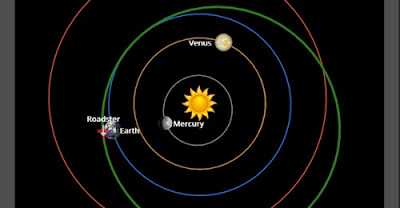Starman and the Tesla
Remember back in March 2017, when engineers at Elon Musk's SpaceX were looking for a dead weight to test their Falcon Heavy launch vehicle? They used Musk's own Tesla Roadster, sending it on a largely unplanned mission to (or beyond) Mars. The range it had was not accurately known.
Typical for Musk, the theatre of the mission was considerable. References to Douglas Adams' Hitchhiker's Guide "trilogy in five parts" were everywhere, and Isaac Asimov also rated a mention. Yes, of course it was a publicity stunt, although it did have some scientific legitimacy.
To cut a long story short, the mission was an outstanding success. The Falcon's upper stage (together with the Tesla) escaped Earth's orbit - just like the Centaur booster in 1966 - and transferred to a heliocentric - sun-centred - orbit. The orbit itself was larger than originally anticipated, and stretches from just inside Earth's to well beyond Mars.
So what's the future for Starman? Two days ago (7 October), its made a not-very-close-approach to Mars, and it will pass close to Earth's orbit (but not Earth) regularly - around about every 18 months. Unlike the Centaur, we're unlikely to ever see it again. The Tesla is constructed of a lot of organic materials (such as leather, carbon fibre and paint). This means it's likely to be entirely destroyed by micrometeorites and solar radiation within a few decades.
If nothing unexpected happens, the Roadster might pass Earth (at about the Moon's distance) in 2091. I won't be around to see it.
After that, if we do see it again, any memory of Elon Musk, his company, exploits and stunts will probably be long gone.
Further reading:
https://www.whereisroadster.com/
https://en.wikipedia.org/wiki/Elon_Musk%27s_Tesla_Roadster
https://en.wikipedia.org/wiki/Surveyor_2

Comments
Post a Comment